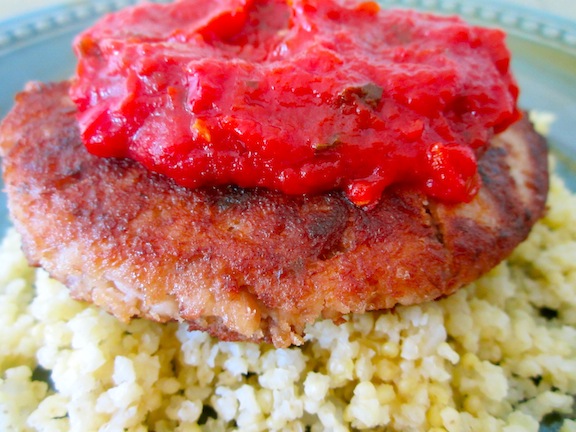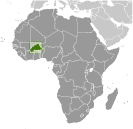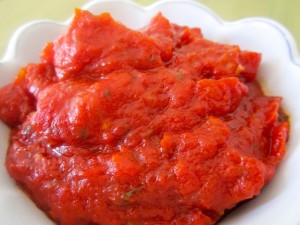 Bean Cake with Spicy Piri Piri Ketchup
Bean Cake with Spicy Piri Piri Ketchup
When I first came up with the idea of this cookbook and started talking about it with my friends, many of them said “I can’t wait to see what you’re going to do for Burkina Faso,” not Togo, Vanuatu, Oman, Djibouti or Eritrea, but Burkina Faso. I have to admit, I was blasé about it, I had already figured out Afghanistan, Algeria and Angola, how hard could Burkina Faso be? Pretty damn hard as it turns out. So let’s start with where and work our way to why then what. Burkina Faso (one of the best country names so far – second only to Azerbaijan in my book) used to be called Upper Volta and was a French protectorate. According to Wikipedia, the name Burkina Faso means “land of upright people,” (or people of integrity) and, while I don’t usually quote Wikipedia without another source, I like this translation so much, I’m sticking with it.
It is a landlocked country in Western Africa surrounded by Mali, Niger, Benin, Togo, Ghana and Ivory Coast.
Which reminds me, congratulations to South Sudan for becoming the newest member state of the UN and getting added to my list of countries for which I need to create a burger – I refuse to change my Twitter ID though, I shall remain @192burgers even though I’ll be making 193 Ok, I gave in, I’m now @193burgers.
Anyway, back to our story. We are going to be spending some time in this part of Africa between Burkina Faso, Burundi and Cameroon, so I’ve spent some time really diving into the current situation in these countries to give a real flavor of the region. Burkina Faso is poor, really poor. According to the CIA World Factbook, they rank 206th out of 228 countries on GDP per capita. According to the UN’s statistics, 56.5% of the population is living on less than $1.25 per day – and that’s $1.25 adjusted to really be $1.25 in purchasing power! Imagine feeding your family on $1.25, paying your mortgage, clothing everyone…I can’t imagine how people do it. Sadly, Burkina Faso isn’t even the worst in the world for poverty rates, Burundi is even worse and depending on the measure you use, some rank even lower than Burundi. But the largest concentration of poor nations is in this part of the world.
We could go into a long tirade here about politics and we could talk at length about human rights and dictators and the amazing uprisings that are happening around the world, but let’s leave that to the political bloggers and focus on the food. Unfortunately, there is a link; given the level of poverty in Burkina Faso we won’t be making a giant beef burger with French bread and a luscious Camembert. Meat is a luxury that goes pretty low on the list when you’re feeding your family on less than $1.25 a day. Burkinabe (yes, that is what you call someone from Burkina Faso) do eat some fresh water fish and chicken, but many get their protein from beans and eggs. So, we are creating a bean cake and spicing it up with Piri Piri sauce. This sauce is common in West African cooking – it’s the West African equivalent of Argentina’s chimichurri sauce (except super hot and spicy!). Piri Piri is served as a condiment and used as a flavoring in many dishes. It’s best if you make it a least a day ahead of time and let it sit overnight at room temperature and absorb the flavors.
Bean cake, check, Piri Piri sauce, check. Easy right? Wrong! Here’s where I went dreadfully wrong. Burkinabe make a traditional rice dish that is cooked in with stewed vegetables – it stretches the veggies and takes advantage of the flavor of the them to make the rice more interesting. So, I whipped up a batch of veggie stew and cooked some rice in it, strained the rice to make the starch layer, plopped the bean cake on the rice then topped the whole thing off with the veggies from the stew. Voila! I had just created vegetable soup on a plate. It was boring, boring, boring. It didn’t suck, but when writing a cookbook, I prefer to not settle for “it doesn’t suck.” So, back to the drawing board. The only things I liked were the bean cake and the Piri Piri sauce. For the starch I decided to return to millet, an inexpensive and tasty grain that we explored in the Benin burger and, if you read the comments for this burger, Zjar gave a really interesting history of the grain and its importance in feeding the world’s hungry. It’s a nice nutty grain with a softer texture than rice. For the burger topping, I figured I would lean into Piri Piri sauce and create a ketchup type of topping. This worked like a charm and the result is a really spicy boldly flavored dish that has a nice balance between the bold flavor of the ketchup and the starchiness of the bean and millet. You can use a store bought veggie burger if you’d like.
I hope you enjoy this, it is easy to make but not for the faint hearted when it comes to spice. If you like your food nice and spicy, be bold and give the Bhutan burger a try – it is easily the spiciest burger I’ve made, and soooo good!
Burkina Faso Burger
15 ounce can of black eyed peas
1 large egg
4 teaspoons Piri Piri Sauce (recipe below)
½ cup fresh bread crumbs
½ teaspoon kosher salt
1 Tablespoon peanut oil
Millet (recipe below)
Piri Piri Ketchup (recipe below)
Drain and rinse peas. In a food processor pulse the peas, egg, bread crumbs and salt until coarsely blended. Form four patties out of the bean mixture (you can refrigerate this mixture if you want until you are ready to use). In a large non-stick skillet, heat the peanut oil over medium high heat until shimmering. Add the bean patties and fry each side until golden brown (about 2 minutes per side). Put a scoop of millet on each plate then add the cooked bean cakes and top with 2-3 Tablespoons of the Piri Piri Ketchup. Serve hot.
Piri Piri Sauce
10 dried bird chilies
1 dried hot Thai chili
1-2 fresh red jalapenos
2 Tablespoons fresh Italian parsley (chopped)
Juice of one lemon
½ teaspoon salt
¼ cup peanut oil
Put all ingredients in a small food processor and pulse until thoroughly combined. Let sit in a glass container at room temperature for at least 12 hours. You can refrigerate after that if you need to, just bring the sauce back to room temperature before using. You can use less of the dried chilies and/or more mild chilies to temper the spiciness if you want. Removing the seeds will also make for a less fiery sauce.
Piri Piri Ketchup
1 Tablespoon peanut oil
½ cup onion diced
6 oz can of tomato paste
2½ Tablespoons Piri Piri Sauce
2 Tablespoons water
1 Tablespoon sugar
1 Tablespoon red wine vinegar
In a small sauce pan, heat peanut oil until shimmering then add onion and cook over medium heat until onions are translucent. Add all other ingredients and simmer over low heat for a least 15 minutes. Serve hot.
Millet
1 teaspoon peanut oil
¼ cup onion diced
½ cup millet
1 cup boiling water
¼ teaspoon kosher salt
In a small sauce pan, heat oil then add onion and cook over medium heat until translucent. Add the millet and cook for 2-3 minutes stirring constantly until millet is golden. Add the water and salt and bring to a boil. Reduce heat to a simmer and cook for 25-30 minutes until millet is desired texture.
https://burgershereandthere.com/?p=484
©Copyright 2011 Linda Monach






This blog is pretty interesting because it inspires you to read up on these obscure cuisines of Africa (and other exotic places) which can be quite thrilling.
I just found out that West African (and Burkinabé – which is from Burkina Faso) cuisine has it’s own kind of own Miso paste, Sumbala, which is some fermented seeds or beans which ha a savoury taste. http://en.wikipedia.org/wiki/Sumbala
Appearently the use of stock cubes in some parts of Africa is just to substitute for Sumbala. That’s pretty interesting, but you’ll probably never ever get a hold of this stuff.
That is what I like about this project too. I just wish I could taste more of the authentic ingredients – especially the cheese. It seems like cheese is the most specific and impossible to duplicate ingredient around the world. I’ll have to see if I can find some Sumbala – sounds interesting….